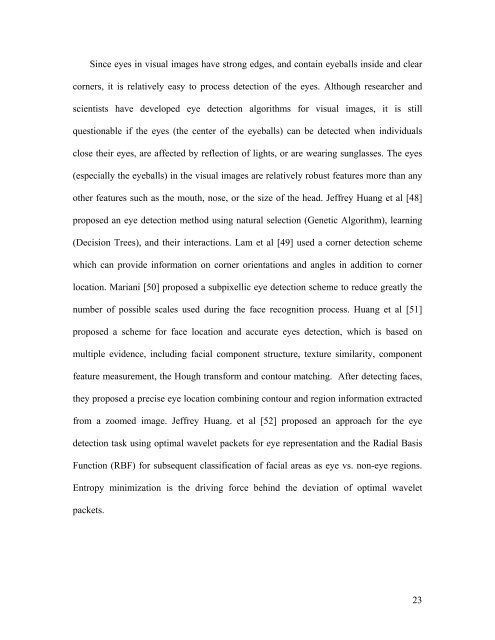Fusion of Visual and Thermal Face Recognition Techniques: A ...
Fusion of Visual and Thermal Face Recognition Techniques: A ...
Fusion of Visual and Thermal Face Recognition Techniques: A ...
You also want an ePaper? Increase the reach of your titles
YUMPU automatically turns print PDFs into web optimized ePapers that Google loves.
Since eyes in visual images have strong edges, <strong>and</strong> contain eyeballs inside <strong>and</strong> clear<br />
corners, it is relatively easy to process detection <strong>of</strong> the eyes. Although researcher <strong>and</strong><br />
scientists have developed eye detection algorithms for visual images, it is still<br />
questionable if the eyes (the center <strong>of</strong> the eyeballs) can be detected when individuals<br />
close their eyes, are affected by reflection <strong>of</strong> lights, or are wearing sunglasses. The eyes<br />
(especially the eyeballs) in the visual images are relatively robust features more than any<br />
other features such as the mouth, nose, or the size <strong>of</strong> the head. Jeffrey Huang et al [48]<br />
proposed an eye detection method using natural selection (Genetic Algorithm), learning<br />
(Decision Trees), <strong>and</strong> their interactions. Lam et al [49] used a corner detection scheme<br />
which can provide information on corner orientations <strong>and</strong> angles in addition to corner<br />
location. Mariani [50] proposed a subpixellic eye detection scheme to reduce greatly the<br />
number <strong>of</strong> possible scales used during the face recognition process. Huang et al [51]<br />
proposed a scheme for face location <strong>and</strong> accurate eyes detection, which is based on<br />
multiple evidence, including facial component structure, texture similarity, component<br />
feature measurement, the Hough transform <strong>and</strong> contour matching. After detecting faces,<br />
they proposed a precise eye location combining contour <strong>and</strong> region information extracted<br />
from a zoomed image. Jeffrey Huang. et al [52] proposed an approach for the eye<br />
detection task using optimal wavelet packets for eye representation <strong>and</strong> the Radial Basis<br />
Function (RBF) for subsequent classification <strong>of</strong> facial areas as eye vs. non-eye regions.<br />
Entropy minimization is the driving force behind the deviation <strong>of</strong> optimal wavelet<br />
packets.<br />
23
















